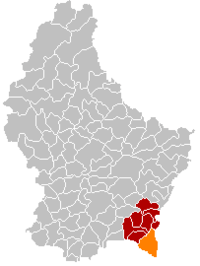Schengen, Luxembourg
| Schengen Schengen | |
|---|---|
| Commune | |
|
A view of Schengen | |
 Map of Luxembourg with Schengen highlighted in orange, and the canton in dark red | |
| Coordinates: 49°28′N 6°22′E / 49.47°N 6.37°ECoordinates: 49°28′N 6°22′E / 49.47°N 6.37°E | |
| Country |
|
| Canton | Remich |
| Government | |
| • Mayor | Ben Homan |
| Area | |
| • Total | 31.42 km2 (12.13 sq mi) |
| Area rank | 21st of 105 |
| Highest elevation | 302 m (991 ft) |
| • Rank | 101st of 105 |
| Lowest elevation | 141 m (463 ft) |
| • Rank | 5th of 105 |
| Population (2014) | |
| • Total | 4,313 |
| • Rank | 32nd of 105 |
| • Density | 140/km2 (360/sq mi) |
| • Density rank | 48th of 105 |
| Time zone | CET (UTC+1) |
| • Summer (DST) | CEST (UTC+2) |
| LAU 2 | LU00008006 |
| Website | schengen.lu |
Schengen (pronounced [ˈʃeŋən]) is a small wine-making village and commune in far south-eastern Luxembourg, on the western bank of the river Moselle, near the tripoint where the borders of Germany, France, and Luxembourg meet. Other villages within the commune include Remerschen and Wintrange. After the mergers with Burmerange and Wellenstein in 2011,[1] the commune has a population of 4,223 with an area of 31.42 square kilometres (12.13 sq mi).
The largest settlement within the commune of Schengen is Remerschen after which the commune used to be named. The name of the commune was changed in 2006[2] to take advantage of the Schengen's name recognition after the signing of the Schengen Agreement there in 1985.
Schengen Castle dates from 1390 but was almost completely rebuilt in the 19th century. It is now a hotel and conference centre.[3]
European Museum
The European Museum was opened on 13 June 2010, 25 years after the signing of the Schengen Treaty, in the Centre européen building.
The permanent, trilingual exhibition on the history and significance of the Schengen Agreements, on 200 m² of exhibition space, shows visitors the elimination of the control of persons at the internal borders, put into practice as one of the four foundational European freedoms in the 1957 Treaty of Rome. The signing of the Agreement is documented with historic photos and video and sound footage as well as statements by those involved at the time.
References
- ↑ "Fusion des communes de Burmerange, Schengen et Wellenstein". Legilux. Government of Luxembourg. Retrieved 13 June 2015.
- ↑ "Loi du 24 juillet 2006 portant changement du nom de la commune de Remerschen en celui de Schengen" (PDF). Journal Officiel du Grand-Duché de Luxembourg: 2661. 30 August 2006. Retrieved 27 December 2012.
- ↑ "Das Schloss von Schengen", Schengen a.s.b.l. (German) Retrieved 27 March 2011.
External links
-
 Media related to Schengen, Luxembourg at Wikimedia Commons
Media related to Schengen, Luxembourg at Wikimedia Commons - Schengen-Tourist
 |
Dalheim | Bous, Remich |  | |
| Mondorf-les-Bains Puttelange-lès-Thionville (FR-57) |
|
Perl (DE-SL) | ||
| ||||
| | ||||
| Beyren-lès-Sierck (FR-57) | Haute-Kontz, Contz-les-Bains, Rustroff (all in FR-57) | Apach (FR-57) |

